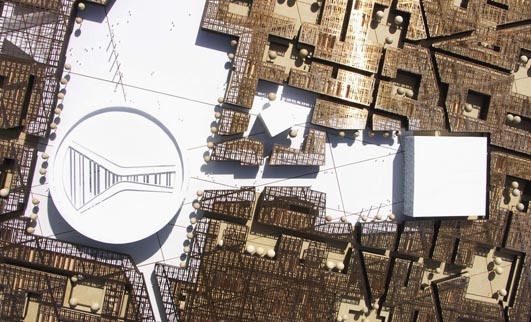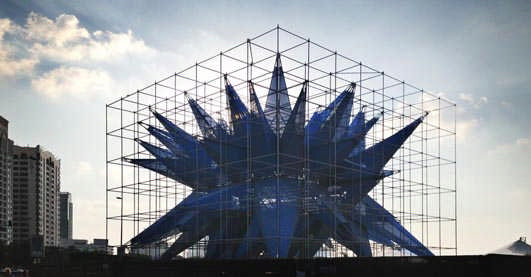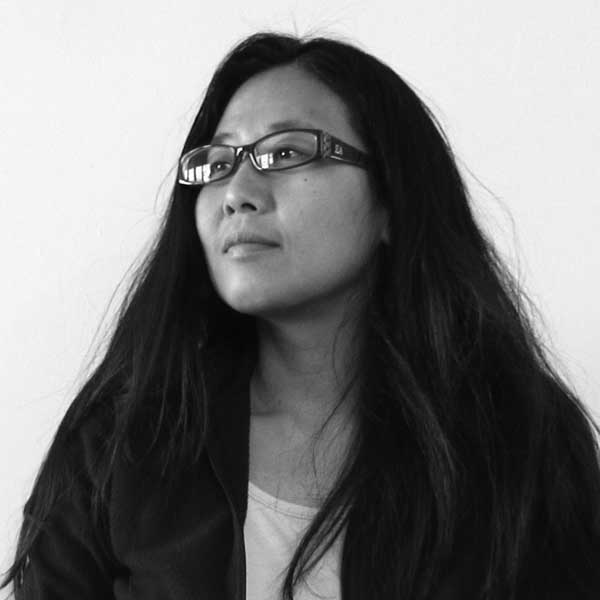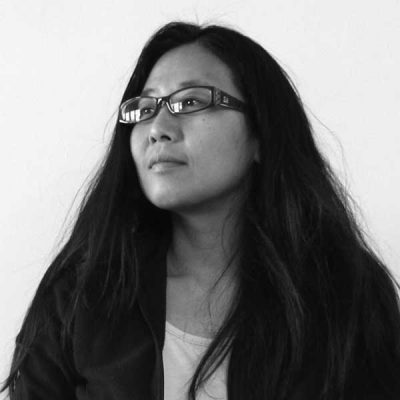Symbolic Architecture, Architectural Comment, Buildings, Architects, Images, News
Architectural Symbolism in an Age of Instability
Contemporary Building + Space – article for e-architect by Joyce Hwang
Jan 15, 2013
Contemporary Architectural Symbolism
By Joyce Hwang
Joyce Hwang is an Assistant Professor in the Department of Architecture at University at Buffalo SUNY. She is also Founder of Ants of the Prairie, USA.
Architectural Symbolism in an Age of Instability
It has been a little over a year after the declared end of the Iraq War, and Iraq’s recovery efforts are starting to pick up momentum. Despite the still-high volume of insurgent-led attacks, the country is intensifying its efforts to rebuild – politically, culturally, and physically.
Part of its arsenal of rebuilding is in the form of architecture, perhaps most notably seen in recent announcements regarding two high-profile design commissions. The new Headquarters for the Central Bank of Iraq has been awarded to Zaha Hadid Architects. Hadid’s office was also shortlisted for the New Iraqi Parliament Complex, a $1 billion USD project which is planned to be built on a site that would have become a “super mosque” under the regime of Saddam Hussein.
Beko Masterplan, Belgrade, Serbia
Design: Zaha Hadid Architects

image : Zaha Hadid Architects
Zaha Hadid’s presence in these nation-resurrecting projects is not a surprise. One could argue that Hadid’s trademark forms have become a new kind of symbolic capital for urban regeneration. Much in the way that the Gehry-designed Guggenheim Museum in Bilbao was scripted as example of architecture’s power to usher in economic resurgence, it seems that we are also turning toward the sinewy formal language of Hadid to call attention to revitalization and rebirth. Consider, for example, Zaha Hadid’s commission for the BEKO Masterplan, a high-stakes urban regeneration project in Belgrade, Serbia, conceived of as a “contemporary mixed-use masterplan, [including] residential, retail and commercial areas along with a large scale convention facility and five-star boutique hotel.”
Her signature geometries have even been allegedly plagiarized, most recently and infamously reported in China. As circulated in the blogosphere, developers of the Meiquan 22nd Century, now under construction in Chongqing, are being accused of “pirating” Hadid’s Wangjing SOHO complex near Beijing. Given the unapologetic demand for Zaha Hadid buildings in territories that are rapidly expanding or rebuilding, it would seem that her aesthetic ‘brand’ is becoming (or has already become) a symbol of anticipated prosperity.
New Iraqi Parliament Complex – Architecture Competition win
Design: Assemblage, Architects

image from architects
Yet, the Iraqi Parliament competition was not won by Hadid. Rather, first prize went to Assemblage, a UK-based office directed by Hannah Corlett and Peter Besley. Assemblage’s proposal is designed using two complimentary yet distinct spatial strategies: one that can be seen as a fabric, a connective tissue of buildings linked by interior and exterior streets and courtyards; the other is that of geometrically austere “landmark” buildings and plazas, which can be read in plan as objects within a field. In terms of spatial and formal resonances, Assemblage’s project couldn’t be more different from Hadid’s recognizably complex forms.
So, what might this decision signify? Yes, the judging of this competition was based on independent evaluations of singular proposals. But one can’t help but wonder if the results are also indicative of a more widespread shift in how we are beginning to think about architecture’s values in the face of instability and crisis. While there is already a long-running ideological debate between formal ‘camps’ (blobs vs. not), it could be argued that increasing economic constraints have started to move some sentiment away from complex geometries, which are typically construed as difficult to build and expensive (although the Iraqi Parliament Complex still has a budget of $1 billion USD, regardless of its ultimate formal resolution).
Still, it is far from satisfying or accurate to say that architecture’s seeming shift toward primitive geometries is based solely on logics of economy. And it is also reductive to posit this as a clearly-defined debate between simplicity and complexity. In the case of Assemblage’s proposal for the Iraqi Parliament, the use of the circle as a primary shape is purposefully direct in terms of its deliberate reference to history and culture.
As they state: “The Council of Representatives building is formed in the shape of a circle: a strong, simple geometry of great architectural power and lineage. In this context as an image of the State, it is a symbol of convergence and stability.” “Direct reference is also made to the historic City of Peace, from which Baghdad takes its name. Having stood just north of the parliament site, the circular city was built by the Abbasid Caliph al-Mansour in 766 AD at a time when Baghdad was at a peak of power and prestige.”
At the same time, the use of the circle is also purposefully subtle in terms of how it is experienced from the street, as well as how it negotiates various axes and patterns of movement. “A circle has no one elevation,” they describe, “presenting the same face to all. Divergent axes are co-ordinated and brought into agreement. The building’s circular plan echoes the shapes of the hemicycles within – themselves a geometry of agreement – and allows views out in all directions from the generous perimeter areas.” The circular shape can therefore be understood in multiple ways, both in terms of what it represents symbolically, as well as how it is experienced as a non-hierarchical mediator.
Whether or not it is intended, architecture almost always evokes some form of meaning to its audience, thereby automatically possessing a kind of symbolic quality. In moments of political crises and economic instability, the symbolic ‘effect’ of architecture takes on an intensified degree of responsibility. Indeed, it is the ‘reading’ of architecture that begins to signify what is at stake, that is, what is considered to be important or not. How intentions are interpreted has resulted in wide-ranging social and political consequences. In times of crises, it could be argued that symbolism takes on a more heightened sense of meaning and urgency.
Wendy Abroad Abu Dhabi, UAE
Design: HWKN, New York

image from architects
The conditions that constitute the ‘values’ of symbolic capital are also changing. In our modern world, we have been demanding that architectural symbols move beyond pure referentiality, and toward performativity. We expect that symbolic architecture will not only stand for something but demonstrate it as well. An example of this is phenomenon is Wendy by HWKN Architects, the most recent iteration of the MoMA PS1 Summer Pavilion. As a pavilion and as the winner of the 2012 MoMA PS1 Young Architects Competition, Wendy first represents — as do all of its predecessors — the institutionally-shepherded rise of young architects in America.
And due to the project’s incorporation of air-cleaning fabric in its design, it also sends a message about contemporary architecture’s position on ‘sustainability.’ The fact that it appears as an attention-grabbing object to behold also makes it more consumable as an architectural symbol. Wendy was recently relocated to the United Arab Emirates for Abu Dhabi’s “Sustainability Week,” an effort sponsored by the Sheika Salama Bint Hamdan Al Nahyan Foundation. The move to Abu Dhabi further confirms its status as a symbol, one that is deployed to send a message, but simultaneously makes itself available for consumption. Wendy’s lightweight, mobile nature, as well as its readiness to ‘fit in’ any context also renders it available for appropriation.
Perhaps it is this last point that sheds light on the changing values of symbolic capital in times of instability. Hadid’s projects certainly can operate as objects of consumption and can readily acquire symbol-status as such. However, her projects’ highly tailored, identity-driven characteristics make it more difficult to imagine them as entities for appropriation. If the aim of a modern parliament building is to enable a “feeling of public ownership and accessibility” and to transmit the hope of “transparency between citizens and their government,” as stated by Assemblage concerning their proposal, it is vital that the opportunity for appropriation is made available to public citizens. How else, otherwise, might architecture convey a sense of open democracy and inclusivity?
Comments on this Architectural Symbolism in an Age of Instability article by Joyce Hwang are welcome.
Joyce Hwang
Articles for e-architect by Joyce Hwang
Public Space – 12 Apr 2011
Resisting Boredom – 25 Jan 2011
Some Thoughts on the 2010 Stirling Prize Winner – 5 Oct + 27 Jul 2010
International Architectural Designs
Yellow River Hotel, Inner Mongolia
Sunlay Design
The Shard photos – exclusive to e-architect
Design: Renzo Piano Building Workshop (RPBW)
Pritzker Prize architects – Architect Winners
Comments re Architectural Symbolism in an Age of Instability welcome






